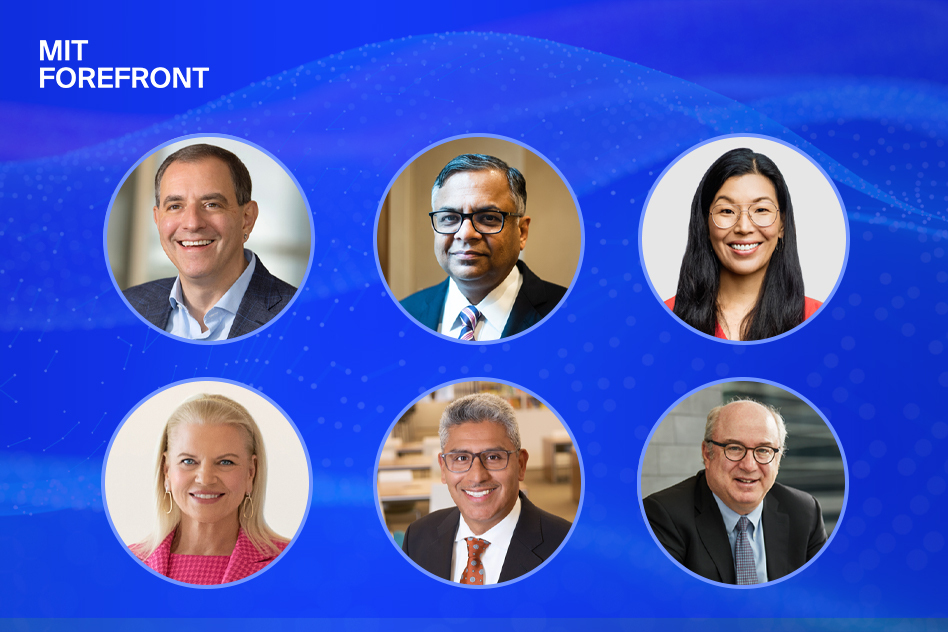Industry, labor, and education leaders discuss the work of the future
At MIT Forefront, panelists explore ways to prepare workers and improve jobs.

“From the research of the MIT Task Force on the Work of the Future, so far, one thing is absolutely clear: Technological change is transforming our work, our lives, and our society — and fortunately, the harsh societal consequences that concern us all are not inevitable,” said MIT President L. Rafael Reif at the start of “From Research to Action: Work of the Future,” on Feb. 19.
The event was the second in the MIT Forefront series, which seeks to find bold, new answers to urgent global problems. It reached more than 33,000 people from all over the world and featured discussion among industry, labor, and education leaders about how to create greater shared prosperity.
“How we design tomorrow’s technologies, and the policies and practices we build around them, will profoundly shape their impact,” Reif said. “In other words, whether the outcome is inclusive or exclusive, fair or laissez-faire, is up to us.”
Launched in spring 2018, the MIT Task Force on the Work of the Future brought together multidisciplinary researchers throughout the Institute to examine how to harness technological innovations for social benefit. This research culminated in the report, “The Work of the Future: Building Better Jobs in an Age of Intelligent Machines.” The Institute is now looking ahead and working to incorporate the Work of the Future agenda into the fabric of MIT, as well as to encourage firms, regions, and institutions more broadly to engage in the “how” of the agenda.
The discussion was moderated by David Autor, co-chair of the MIT Task Force on the Work of the Future and Ford Professor of Economics, and focused on interactions between work and rapidly advancing technology — and opportunities to enhance both.
Ginni Rometty, former executive chairman, president, and chief executive officer of IBM, described some of the evolving reasons behind, and the multiple substantial challenges involved in, creating a more inclusive workforce.
“I could see a digital divide growing between ‘have’ and ‘have not,’” she said. “As [new] technologies came out, they would change 100 percent of jobs, in a really quick time frame. We had to do something to bring this technology safely into the world, and ‘safely’ means that it can help people make a good living.”
Rometty also outlined systemic barriers to building a more inclusive workforce — and ways to work toward overcoming these barriers — including implementing a “skills-first” rather than a “degrees-only” approach, linking supply and demand (such as by producing college apprenticeships that teach technical and soft skills), opening new career pathways within companies, building new policy, and addressing bias in the workplace.
Natarajan Chandrasekaran, executive chair of Tata Sons and author of “Bridgital Nation: Solving Technology's People Problem,” spoke to the challenge of bringing 90 million people, between now and 2030, into the workforce in India. This is four times the combined number of people that the United States, Indonesia, and Brazil will add to the workforce in the same time period.
“While Western countries have always created middle-income jobs in the manufacturing sector, in India, most of the jobs have come from non-manufacturing sectors like petrochemicals, telecommunications, and IT,” he said. “More than 60 percent of the workforce is in the agricultural sector, and many of these workers are moving toward middle-income jobs like construction. Deploying AI will increase middle-income jobs because we will be employing people who are ‘low-skill’ or ‘no-skill’ to do higher-level skill jobs.”
Chandrasekaran explained that AI can also be helpful in dealing with the shortages in India of certain professionals such as doctors, nurses, and teachers.
Ai-jen Poo, co-founder and executive director of the National Domestic Workers Alliance, spotlighted the incredible challenges brought into the foreground during the Covid-19 pandemic facing home health-care workers in the United States.
“We have spent way too much time thinking about upskilling the worker, which is, of course, really important,” she said. “But I would like us to take more time talking about how we upgrade the jobs. There are millions upon millions of workers in this country who work incredibly hard and simply cannot make ends meet. And many of those jobs, it turns out, are essential to our health, our safety, and our well-being.”
A home health care worker, for example, will make an average of $17,000 per year, have no paid time off, and have no health care benefits. During the Covid-19 pandemic, these workers have ended up paying out-of-pocket for safer modes of transportation and regular Covid-19 tests, have had difficulties finding personal protective equipment, and also might have children at home needing internet access for remote schooling. These circumstances — faced by millions of workers — said Poo, all point to a need to “address the epidemic of low-wage work in America, raise the floor, raise wages, and create a safety net that actually keeps people safe.” She said that she sees the current moment of economic recovery as the “single greatest opportunity we have to reset” and create substantial policy change, particularly in terms of the care economy.
Peter Slavin, president of Massachusetts General Hospital, spoke further about the health care sector and its potential.
“Health care can play an important role in making the workforce and our country more equitable,” he said. “There are lots of entry-level positions within health care that don’t require much in the way of education, and there are career ladders that can be built to give individuals opportunities to advance.”
Slavin noted that technology does sometimes highlight inequity, citing medical record software rolled out over the last few years that has been used mostly by higher-income communities. He sees health care as still in the early stages in its use of AI, and identifies great potential in AI for complementing the work of employees and providing decision-making support to doctors and other clinicians.
Juan Salgado, chancellor of the City Colleges of Chicago, shared perspectives through the lens of education and the importance of not only preparing students with skills and opportunities, but also upgrading jobs.
“Our students are 54 percent food-insecure and housing-insecure,” he said, citing a student survey conducted before the Covid-19 pandemic. “[They] were more likely to be food- and housing-insecure if [they] had a job. Our students are trying to find a way to make work ‘work’ for them, while finding a way to make a career and move into the middle class. We need to find ways to tap into that talent in ways that are new and dynamic.”
Salgado advocated for more of a K–14 rather than a K–12 educational system, in which there is always a built-in, post-secondary plan. He also highlighted the importance of not only teaching students relevant skills but also helping them build valuable relationships with mentors and professionals.
All panelists echoed the theme that although technology will certainly change jobs in a variety of ways, it will not necessarily replace workers — and the types of technology used have to be very strategic, with decisions around implementation made with the worker in mind.
“You can’t just throw in the technology randomly,” said Rometty. “It has to help workers do their job better.”





































